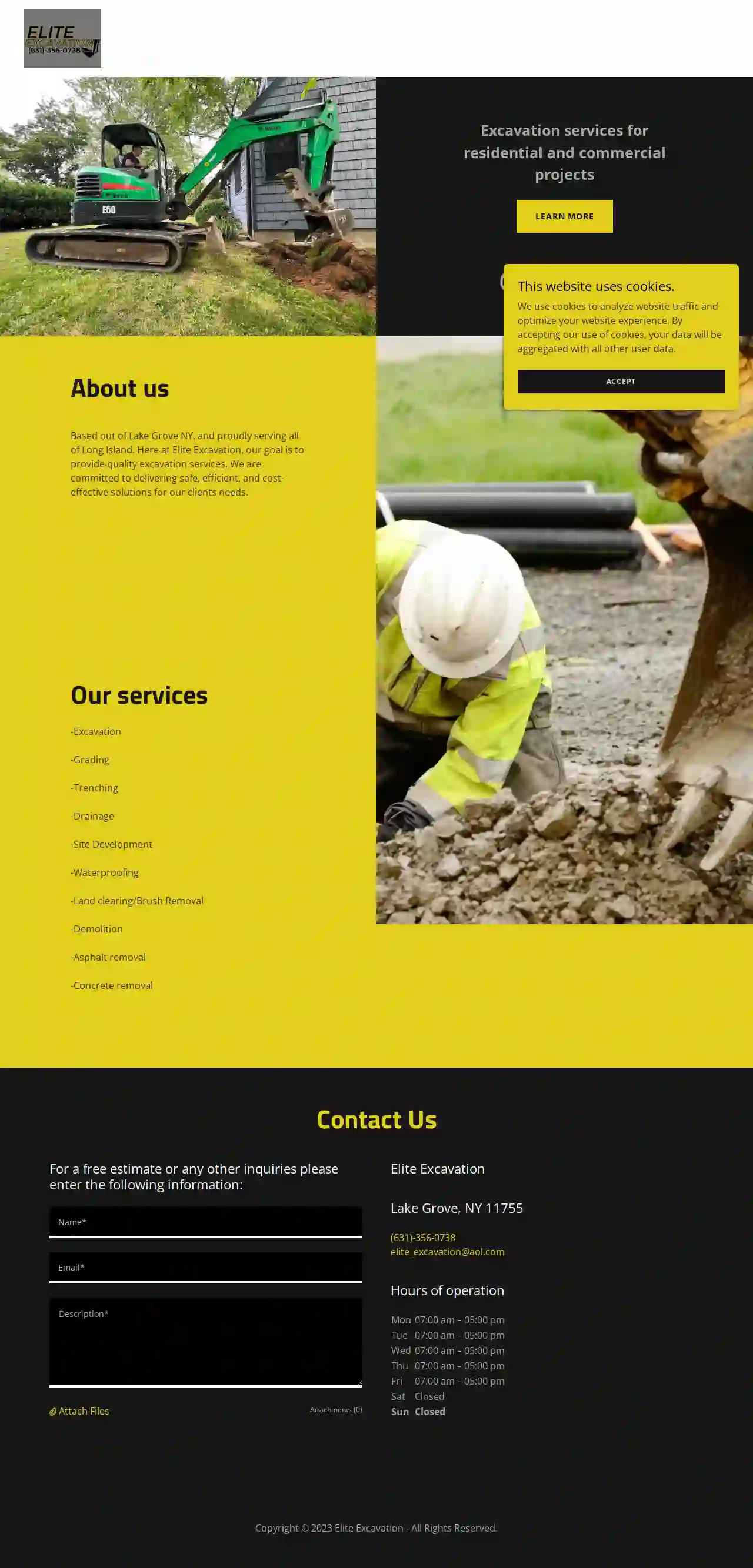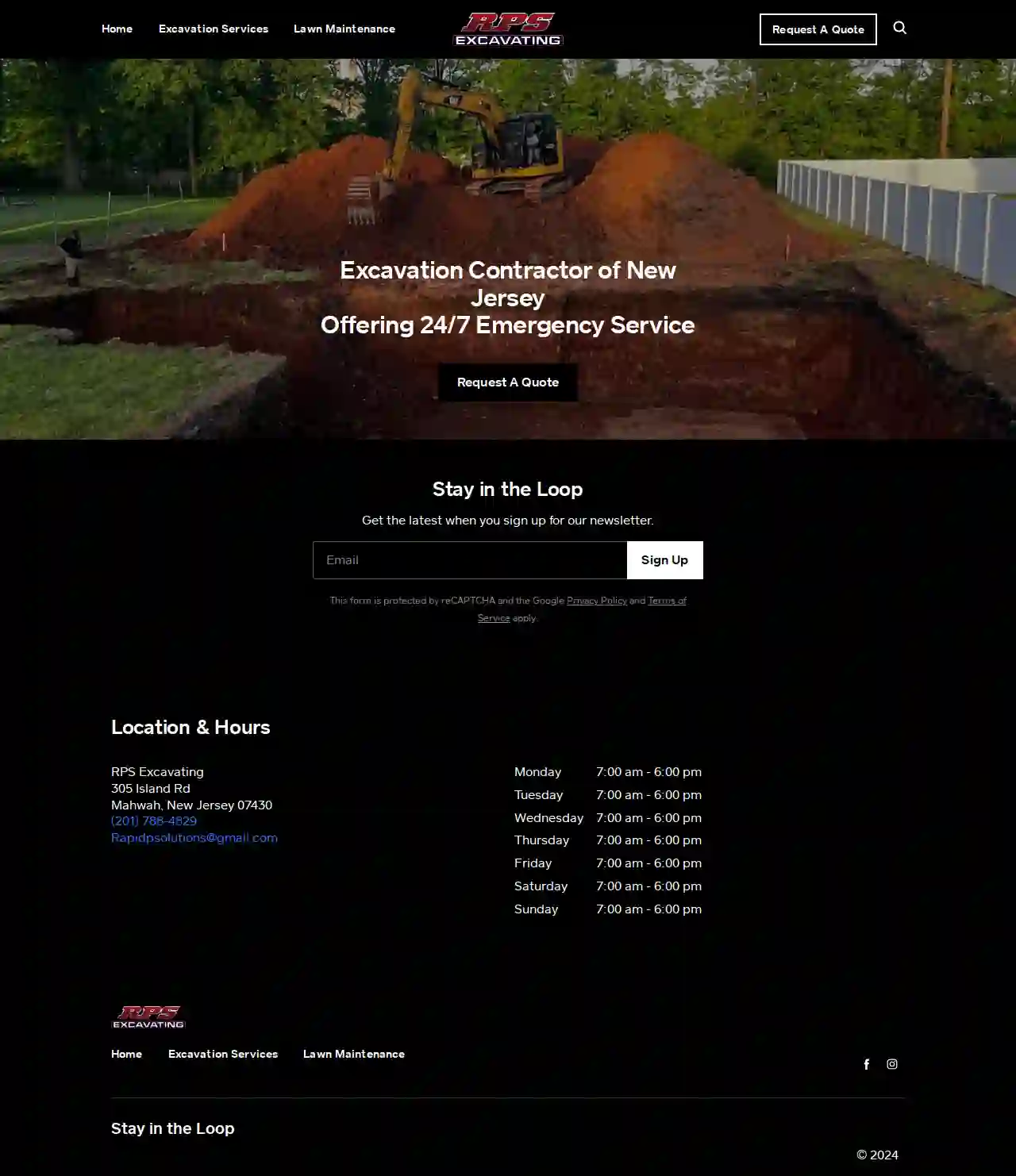Demolition Contractors University at Buffalo
Find the best Local Demolition Contractors in University at Buffalo
Get multiple Demolition Contractors Near Me quotes for your project today! Compare profiles, reviews, accreditations, portfolio, etc... and choose the best offer.

Ground Control Excavating Inc.
3.73 reviewsWarwick, USComplete Site Development, Excavation, & More… We provide complete land and site development services for projects of all sizes, including government, commercial, public, private, emergency, and residential projects. Ground Control Excavating, Inc. offers complete excavation services for residential and commercial projects. A premiere land-site excavating contractor, as well as, first-responder for emergencies and natural disasters in the NY area, we are committed to providing the highest level of quality to our customers throughout Orange, Sullivan, Rockland, Westchester counties and the entire Hudson Valley, NY area. GCE is based out of Warwick, NY. We provide complete site development, road development, rock hammering, rock crushing, concrete recycling, underground utilities, septic systems, drainage, top soil, and much more. We service Warwick, Monroe, Middletown, Goshen, Newburgh and the entire Hudson Valley. Experienced Construction Professionals We will work with you to achieve a common goal on time and on budget!
- Services
- Why Us?
- Gallery
Get Quote
LONG ISLAND EXCAVATION
240 Elwood Road, East Northport, 11731, USBongiorno's Contracting Professional groundwork and excavation service from one of the leading construction excavation companies in New York. There is a lot more to groundwork than just moving earth. Our extensive experience ensures that all concerns and laws relating to the environment, civil engineering and health and safety are taken into account to give you peace of mind. Reasons for Choosing Our Company Established 70 years in business on Long Island Licensed and Insured Home Improvement Contractors No Sub-Contracting, All the work is done by our team Many Recent Job References Family Owned and Operated Using only quality materials Forms of Payments Excepted: Credit Cards (VISA, Mastercard, American Express, Discover), Personal checks, Cashier Checks. Suffolk County Home Improvement License 9615-H Our Team (Left to Right) Charles F. Bongiorno 111 - Charles F. Bongiorno Jr. - Charles F. Bongiorno Sr. Corporate Office Chuck Bongiorno As. Bs. Ms. 240 Elwood Road East Northport, New York 11731 Business Phone: (631) 368-9086 Cell Phone: (631) 848-3190 Yard: (631) 368-8123 Email: [email protected]
- Services
- Why Us?
- Our Team
- Gallery
Get Quote
Elite Excavation
51 reviewsLake Grove, NY, 11755, USAbout us Based out of Lake Grove NY, and proudly serving all of Long Island. Here at Elite Excavation, our goal is to provide quality excavation services. We are committed to delivering safe, efficient, and cost-effective solutions for our clients' needs.
- Services
- Why Us?
- Gallery
Get Quote
PinPoint Grading & Site Development
31 reviewsGreensboro, USAbout PinPoint Grading and Site Development PinPoint Grading and Site Development is Greensboro's premier land services provider. Rooted in the heart of North Carolina, we've built a reputation for transforming landscapes with precision and dedication. Our team, deeply connected to the Greensboro community, is committed to delivering unparalleled quality in every project, ensuring that visions turn into realities. Why Choose Us? Our team is a collective of highly-skilled professionals, each with years of specialized experience in the fields of civil engineering, landscape architecture, and land development. Their depth of knowledge ensures that your project is in the most capable hands. We don't just meet industry standards, we aim to exceed them. Our commitment to quality is unwavering, ensuring that every service we provide is executed with the utmost precision and excellence. Integrity is at the core of what we do. From the initial consultation to the final invoice, we maintain complete transparency in all our operations and pricing, so you can trust that there are no hidden fees or surprises.
- Services
- Why Us?
- Gallery
Get Quote
New Bridge Contracting Corp
52 reviews123 Newbridge Ave, Toronto, M4W 2P3, USAbout Newbridge Contracting Inc. Newbridge Contracting Inc. is a reputable and experienced general contracting company serving the Greater Toronto Area. We are dedicated to providing high-quality construction services for both residential and commercial clients. Our team of skilled professionals is committed to delivering projects on time and within budget, while maintaining the highest standards of workmanship. We understand that building or renovating your home or business is a significant investment. That's why we take a personalized approach to every project, working closely with our clients to ensure their vision is realized. From initial planning and design to final construction and completion, we are with you every step of the way. At Newbridge Contracting Inc., we pride ourselves on our commitment to customer satisfaction. We believe in building lasting relationships with our clients, based on trust, transparency, and open communication. We are confident that you will be pleased with the results of your project.
- Services
- Why Us?
Get Quote
Shackelford Construction and Hauling, LLC
4.76 reviews350 South Industrial Parkway, Yazoo City, USAbout Us Shackelford Construction and Hauling, LLC is a Mississippi-based construction company, with additional offices in Houston, TX, and yards located in New Mexico, Texas, South Carolina, and Georgia. We specialize in a range of services including land clearing, demolition, excavation, grading, soil stabilization, storm drainage, stone placement, concrete, building, and site maintenance for the railroad, oilfield, energy, industrial, and large commercial industries. Our top priorities are safety and customer satisfaction. Shackelford is licensed to operate in 30 states across the United States on individual projects up to 55 million dollars. Our client list ranges from all class 1 railroads and privately-owned short lines to oil and gas, chemical, industrial, and energy. Our Mission Finish every job ahead of schedule and without incident, allowing our customers the earliest possible financial return on their investment. Team Jay Shackelford Owner 38 years of experience Hunter Shackelford Operations Manager 26 years of experience Alfonzo Hernandez Safety Manager 26 years of experience Reeves Shackelford Manager of Estimating & Project Management 27 years of experience Clint Shackelford Business Development 14 years of experience Reeves Shackelford Estimating & Project Management
- Services
- Why Us?
- Our Team
- Gallery
Get Quote
Carolina Excavation Specialties LLC
528 reviewsGarner, NC, 27529, USUnparalleled Excavation Services & Solutions The Excavation & Grading Team You Can Rely On! PREMIER EXCAVATION CONTRACTOR Proudly Serving Apex, NC; Chapel Hill, NC; Raleigh, NC; and Youngsville, NC If you’re looking for a hardworking, dedicated team of excavation and grading contractors to tackle your excavation job, you’ve come to the right place! Carolina Excavation Specialties LLC is an authority in the industry that provides a comprehensive list of excavation services and more for residential and commercial properties throughout the Apex, NC; Chapel Hill, NC; Raleigh, NC; and Youngsville, NC areas. These services include: ● Excavation ● Utilities ● Septic System Install & Repairs ● Culverts, Ditching & Storm Drainage ● Demolition Services ● Erosion Control ● Retention Ponds ● Grading ● Gravel Pads & Driveways ● Land Clearing ● Foundations ● Retaining Walls ● Roof Drainage ● Asphalt/Concrete More About Us
- Services
- Why Us?
- Our Team
- Testimonials
- Gallery
Get Quote
RPS Excavating
518 reviews10000 County Rd 12, Seaforth, N0L 1P0, USAbout RPS Excavating RPS Excavating is a family-owned and operated business with over 20 years of experience in the excavating industry. We are committed to providing our clients with high-quality services at competitive prices. We specialize in a wide range of excavating services, including: Site preparation Grading Demolition Utility installation Drainage And more! We are fully licensed and insured, and we have a team of experienced and qualified professionals who are dedicated to providing our clients with the best possible service. We are committed to safety and environmental responsibility, and we always strive to exceed our clients' expectations. Contact us today for a free estimate!
- Services
- Why Us?
Get Quote
Christiana Excavating Co.
4.610 reviews2016 Sunset Lake Road, Newark, 19702, USAbout Us Christiana Excavating Co. was founded in 1989 by Mike Connor and later joined by his brother, Paul Connor, in 2001. Teamed with a great staff, the company grew exponentially into the successful business it is today. CEC is a leading site excavating and underground utilities contractor serving all three counties in Delaware. The Connor brothers’ handshake business men reputation stands true today and is evident in every project they carry across the finish line. The valuable lessons and knowledge gained over the years by Mike and Paul Connor, has been dutifully passed down to CEC’s key personnel, and is an integral part of partnering with their clients. Christiana Excavating is a preferred site development contractor performing large scale residential and commercial projects. With hard work, diligence, and customer satisfaction a priority, great working relationships with clients and colleagues in the industry have been established. Christiana Excavating’s impressive fleet consists of excavators and dozers of all scales, a crusher to provide approved recycled aggregate for GABC placements, curb machine and highly integrated GPS systems in equipment for efficiency. CEC believes in offering quality work done correctly and efficiently, while staying within budget and focusing on safety. Safety is of paramount importance to our employees and our colleagues on the job site.
- Services
- Why Us?
- Our Team
- Gallery
Get Quote
Triple J Land Services - Dirt Works
52 reviewsHuntsville, USDiscover the Most Trusted Excavation Company in Livingston, TX When it comes to delicate excavation projects in Livingston, TX, there’s only one name you need to know: Triple J Land Services. With a proven track record of reliable experience and exceptional service throughout the greater area, including Madisonville, The Woodlands, Livingston, and College Station, we are the team you can trust with your valuable projects. Revitalize Your Land with Unmatched Excavation Services in Livingston, TX Contact our local excavation and land clearing company serving Livingston, TX and surrounding areas Looking to transform your land in Livingston, TX, and the surrounding areas into something extraordinary? Your search ends here! Triple J Land Services is your ultimate resource, equipped with years of expertise, cutting-edge techniques, and an unwavering commitment to excellence. Since 2008, we have been providing top-quality services such as tree removal, dirt work, and excavation, ensuring every project, regardless of size, is handled with ease and precision. With our specialized crew members, we deliver quick and efficient results while taking care of all necessary permits along the way. Whether you require a stunning onsite pond or cleared roads for a driveway installation, trust us to bring your vision to life. Contact us today for a free estimate!
- Services
- Why Us?
- Testimonials
- Gallery
Get Quote
Over 22,076+ Excavation Contractors in our network
Our excavation contractors operate in University at Buffalo and surroundings!
ExcavationHQ has curated and vetted the Best Excavation Pros in and around University at Buffalo. Find a reliable contractor today.
Frequently Asked Questions About Demolition Contractors
- General Liability Insurance: Covers bodily injury or property damage to third parties caused by the contractor's negligence.
- Workers' Compensation Insurance: Provides benefits to workers injured on the job.
- Pollution Liability Insurance: Covers costs associated with environmental contamination caused by demolition activities.
- Professional Liability Insurance: Protects against claims of negligence or errors in professional services, such as demolition planning or consulting.
- Recycling: Concrete, brick, metal, and wood can be recycled and reused in other construction projects, reducing waste sent to landfills.
- Landfill Disposal: Non-recyclable materials are disposed of in designated landfills according to local regulations.
- Donation: Some materials, such as fixtures or appliances, may be suitable for donation to charitable organizations.
- 'Can I see proof of your licensing and insurance?' Verify their credentials and coverage.
- 'What experience do you have with projects like mine?' Ensure they have relevant expertise.
- 'Can you provide references from past clients?' Check their reputation and customer satisfaction.
- 'What are your safety protocols?' Prioritize contractors who emphasize safety.
- 'How will you handle hazardous materials?' Ensure they have proper procedures for asbestos or lead abatement.
- 'What is your timeline for completing the project?' Understand the project duration.
- 'How will you manage noise, dust, and debris?' Discuss mitigation measures for minimizing disruption.
- 'What are your payment terms?' Clarify payment schedules and any required deposits.
- Size and Complexity of the Structure: Larger and more complex structures, such as multi-story buildings, require more time, labor, and specialized equipment, increasing costs.
- Type of Demolition: Different demolition methods, such as implosion, wrecking ball, or high-reach demolition, have varying costs.
- Material Disposal: Disposal fees for demolition debris can contribute significantly to the overall cost, depending on the type and quantity of materials.
- Location and Accessibility: Demolition in densely populated areas or with limited access may require more planning and specialized equipment, affecting costs.
- Hazardous Materials: The presence of asbestos, lead paint, or other hazardous materials requires specialized removal and disposal procedures, adding to the expenses.
What is the importance of insurance in demolition projects?
What happens to the debris after demolition?
What questions should I ask a demolition contractor before hiring them?
How much does demolition cost in the USA?
What is the importance of insurance in demolition projects?
- General Liability Insurance: Covers bodily injury or property damage to third parties caused by the contractor's negligence.
- Workers' Compensation Insurance: Provides benefits to workers injured on the job.
- Pollution Liability Insurance: Covers costs associated with environmental contamination caused by demolition activities.
- Professional Liability Insurance: Protects against claims of negligence or errors in professional services, such as demolition planning or consulting.
What happens to the debris after demolition?
- Recycling: Concrete, brick, metal, and wood can be recycled and reused in other construction projects, reducing waste sent to landfills.
- Landfill Disposal: Non-recyclable materials are disposed of in designated landfills according to local regulations.
- Donation: Some materials, such as fixtures or appliances, may be suitable for donation to charitable organizations.
What questions should I ask a demolition contractor before hiring them?
- 'Can I see proof of your licensing and insurance?' Verify their credentials and coverage.
- 'What experience do you have with projects like mine?' Ensure they have relevant expertise.
- 'Can you provide references from past clients?' Check their reputation and customer satisfaction.
- 'What are your safety protocols?' Prioritize contractors who emphasize safety.
- 'How will you handle hazardous materials?' Ensure they have proper procedures for asbestos or lead abatement.
- 'What is your timeline for completing the project?' Understand the project duration.
- 'How will you manage noise, dust, and debris?' Discuss mitigation measures for minimizing disruption.
- 'What are your payment terms?' Clarify payment schedules and any required deposits.
How much does demolition cost in the USA?
- Size and Complexity of the Structure: Larger and more complex structures, such as multi-story buildings, require more time, labor, and specialized equipment, increasing costs.
- Type of Demolition: Different demolition methods, such as implosion, wrecking ball, or high-reach demolition, have varying costs.
- Material Disposal: Disposal fees for demolition debris can contribute significantly to the overall cost, depending on the type and quantity of materials.
- Location and Accessibility: Demolition in densely populated areas or with limited access may require more planning and specialized equipment, affecting costs.
- Hazardous Materials: The presence of asbestos, lead paint, or other hazardous materials requires specialized removal and disposal procedures, adding to the expenses.